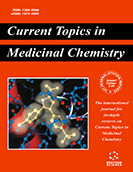Abstract
With computer-aided drug design established as an integral part of the lead discovery and optimization process, pharmacophores have become a focal point for conceptualizing and understanding receptor-ligand interactions. In the structure-based design process, pharmacophores can be used to align molecules based on the threedimensional arrangement of chemical features or to develop predictive models (e.g., 3DQSAR) that correlate with the experimental activities of a given training set. Pharmacophores can be also used as search queries for retrieving potential leads from structural databases, for designing molecules with specific desired attributes, or as fingerprints for assessing similarity and diversity of molecules. This review article presents a historical perspective on the evolution and use of the pharmacophore concept in the pharmaceutical, biotechnology, and fragrances industry with published examples of how the technology has contributed and advanced the field.
Keywords: Pharmacophore, OLFACTOPHORES
Current Topics in Medicinal Chemistry
Title: History and Evolution of the Pharmacophore Concept in Computer-Aided Drug Design
Volume: 2 Issue: 12
Author(s): Osman F. Guner
Affiliation:
Keywords: Pharmacophore, OLFACTOPHORES
Abstract: With computer-aided drug design established as an integral part of the lead discovery and optimization process, pharmacophores have become a focal point for conceptualizing and understanding receptor-ligand interactions. In the structure-based design process, pharmacophores can be used to align molecules based on the threedimensional arrangement of chemical features or to develop predictive models (e.g., 3DQSAR) that correlate with the experimental activities of a given training set. Pharmacophores can be also used as search queries for retrieving potential leads from structural databases, for designing molecules with specific desired attributes, or as fingerprints for assessing similarity and diversity of molecules. This review article presents a historical perspective on the evolution and use of the pharmacophore concept in the pharmaceutical, biotechnology, and fragrances industry with published examples of how the technology has contributed and advanced the field.
Export Options
About this article
Cite this article as:
Guner F. Osman, History and Evolution of the Pharmacophore Concept in Computer-Aided Drug Design, Current Topics in Medicinal Chemistry 2002; 2 (12) . https://dx.doi.org/10.2174/1568026023392940
| DOI https://dx.doi.org/10.2174/1568026023392940 |
Print ISSN 1568-0266 |
| Publisher Name Bentham Science Publisher |
Online ISSN 1873-4294 |
 15
15
- Author Guidelines
- Bentham Author Support Services (BASS)
- Graphical Abstracts
- Fabricating and Stating False Information
- Research Misconduct
- Post Publication Discussions and Corrections
- Publishing Ethics and Rectitude
- Increase Visibility of Your Article
- Archiving Policies
- Peer Review Workflow
- Order Your Article Before Print
- Promote Your Article
- Manuscript Transfer Facility
- Editorial Policies
- Allegations from Whistleblowers
- Announcements
Related Articles
-
Static Cerebral Blood Flow Autoregulation in Humans
Current Hypertension Reviews B Cells and Beyond: Therapeutic Opportunities Targeting Inflammation
Inflammation & Allergy - Drug Targets (Discontinued) Urinary Tract Infection in Children
Recent Patents on Inflammation & Allergy Drug Discovery Urate Transport: Regulators of Serum Urate Levels in Humans
Current Rheumatology Reviews Progress in the Diagnosis and Treatment of Pulmonary Aspergillosis
Current Respiratory Medicine Reviews Update on the Management of Spondyloarthritis in Asian Countries
Current Rheumatology Reviews Monoclonal Antibodies in the Treatment of Systemic Lupus Erythematosus
Current Drug Targets Clozapine Safety, 35 Years Later
Current Drug Safety Down-regulating Glypican-3 Expression: Molecular-targeted Therapy for Hepatocellular Carcinoma
Mini-Reviews in Medicinal Chemistry Flare-Up Phenomenon of Intradermal Test with Anaphylactic Reaction to Paracetamol (Acetaminophen)
Recent Patents on Inflammation & Allergy Drug Discovery The Pharmacological Pathways of GnRH Mediating the Inhibition of Mammary Tumours: Implications in Humans and Domestic Animals
Current Medicinal Chemistry Editorial [ A Novel Immunobiological Drugs in Dermatology Guest Editor: Neslihan ??endur ]
Anti-Inflammatory & Anti-Allergy Agents in Medicinal Chemistry Differential Expression of Genes in Obesity and Type 2 Diabetes Mellitus
Current Nutrition & Food Science Albumin Competitively Inhibits Glycation of Less Abundant Proteins
Protein & Peptide Letters Evaluating the Relationship Between Serum Level of Interleukin-6 and Rheumatoid Arthritis Severity and Disease Activity
Current Rheumatology Reviews Functional Renal MRI
Current Medical Imaging Identification of Novel Anti-inflammatory Agents from Ayurvedic Medicine for Prevention of Chronic Diseases: “Reverse Pharmacology” and “Bedside to Bench” Approach
Current Drug Targets Current Signal Transduction Therapy for Brain Tumors Review Article
Current Signal Transduction Therapy Exercise as an Anabolic Stimulus for Bone
Current Pharmaceutical Design B Cell Modulation Strategies in Autoimmunity: The SLE Example
Current Pharmaceutical Design


























